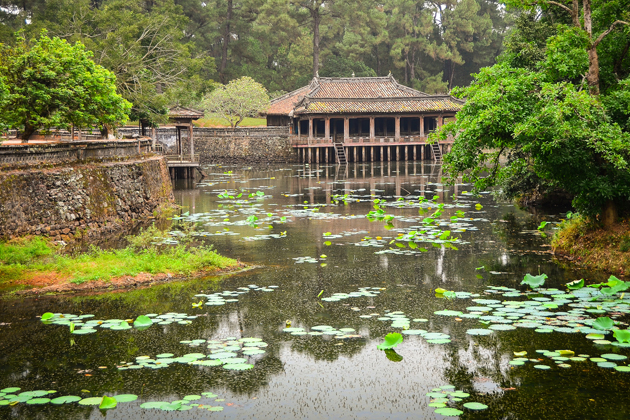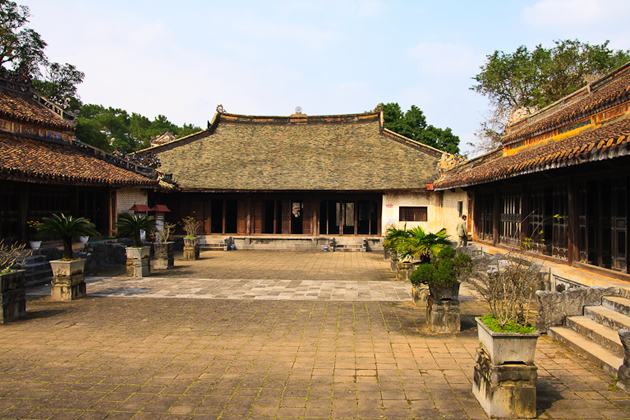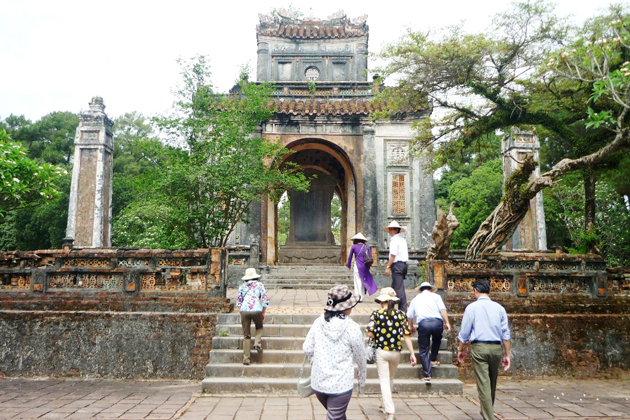With the soft lines, Tu Duc Tomb is viewed from above as a gorgeous painting and listed as one of the most beautiful architectures in the 19th century. With fussy construction and tranquil natural beauty, it can be said that Tu Duc Tomb is the most beautiful royal tomb in Nguyen Dynasty. Each smallest structure expresses the romantic and dreamy soul of this talent Emperor. Tomb of Tu Duc is a cluster of architecture works including the King’s Burial site. It is located in a narrow valley in Duong Xuan Thuong village which is Thuong Ba village, Thuy Xuan Commune, Hue City.

History of Tu Duc Tomb
Tu Duc Tomb had several names based on each particular time in its history. At first, the tomb was built in 1864 by about 50 millions workers including both soldiers and farmer and was named Van Nien Co (means permanent work). To build the work on time (after 6 years), hundred millions of farmer and workers had to work extremely hard from early morning to late in the evening, while the living standard of these people was not improved or even worsened: there was not adequate food to eat or clothes to wear; they usually suffered from violence. It was that extreme work that caused them to be fiercely against the king during that time.

After two years, because they couldn’t stand the oppression anymore, they decided to fight for their right. Although the rebellion was failed, the king finally decided to change the name of his tomb to be Khiem Cung (Khiem Palace) and write an article to apologize to his residence. It was not until 1873 that Khiem Cung was done. After the death of Tu Duc, its name was distorted into Khiem Lang (Khiem Tomb).
Structure of Tu Duc Tomb
In spite of living a luxurious life with up to 104 wives and countless concubines, Tu Duc had no child. Maybe that’s the reason why he constructed his tomb with all his heart. The consequence is Tu Duc Tomb is about 12 hectares – ten times larger than that of Gia Long!
The layout of the tomb includes the tomb and the temple area with about 50 big and small architecture works spreading in the cluster over the monument. One special feature is that all of the constructions here were named with the word “Khiem” (modesty) in them so that the king can show his humility, as well as his apology to the worker, who died during building the tomb.

The tomb is just like a small-in-size park thanks to the appearance of Tinh Khiem island where rare animals and flowers were nourished in the middle of Luu Khiem lake. The lake also houses Xung Khiem Pavilion and Du Khiem Pavilion where the king often retreated to enjoy his elegant activities such as seeing flowers or reading books. Especially, there is a royal theatre for the king in the monument named Minh Khiem Chamber which is considered one of the oldest theatres preserved in Vietnam. It is also the place where the king expressed his romantic soul with numerous decorating patterns and stars. The tomb area is behind the temple area. The Honour Courtyard with two lines of mandarins, horses, and elephants is right at the beginning of the area.
Behind the Honour, Courtyard stands the Stele Pavilion with 20 tons stele inside of it. On the stele engraved the self- inscription of Tu Duc king which describes his own life, achievements, and failures because he didn’t have any offspring to build up a stele for him like the previous Emperors. Right behind the stele place the two pillars representing the king’s power and talent.
There is also a special area in the complex that not many people know; that’s Boi Tomb – the burial place of the seventh king of Nguyen Dynasty, King Kien Phuc. Kien Phuc was adopted by Tu Duc when he was 2 years old. He acceded in 1883 after the death of Tu Duc, but only after 8 months of reining, he suddenly passed away.
Not until 1883 when the tomb had been done for 10 years that Tu Duc died and was solemnly buried in this dreamy beautiful tomb. Lately, Tu Duc Tomb has attracted ted myriad number of tourists due to its heavenly beauty and peaceful atmosphere.
Tu Duc Tomb Opening Hours - Entrance Fee - Dresscode
Entrance fee: 150.000VND/ pax
Opening Hours: 8.00 am to 6.00 pm
Dresscode: Polite & elegant clothes



Tu Duc Tomb is located on 6 kilometers from the center of Hue. In 1864, King Tu Duc chose a hill in Duong Xuan Village to construct a residence, with the intention of transforming the architectural ensemble into a tomb. The constructions were completed in 1867, covering an area of 225 hectares.
The section reserved for the residence evokes a park with two principal gates, Vu Khiem Gate being the current entry. From there, a tiled alley divides the area into two sections: on the left are habitations and cult shrines built on the slope of a hill; on the right, at a lower level, is the Luu Khiem Lake. The lake has two pavilions on stilts, Xung Khiem Ta, and Du Khiem Ta, and the islet Tinh Khiem planted with exotic flowers and provided with small caverns for the rearing of rare animals.
The lake is covered with lotuses and there is a forest of pine trees on the opposite bank. Near Vu Khiem gate, there is a temple dedicated to the god of the mountain, then Chi Khiem Duong, a house reserved for the cult of the ladies of anterior reigns and of King Tu Duc's wives. Luc Vien was the accommodations for the royal concubines, and Loc Đong, a garden for rearing deer. The principal altar is Hoa Khiem Palace, with Luu Khiem (the King’s rest house) behind it. This building was later devoted to the cult of the Queen Mother Tu Du. On the right, On Khiem Duong serves as the storehouse and also as the habitation for the concubines. The section of sepulture comprises the Court of Audiences (Bai Dinh) with two rows of human statures, the Court of Sacrifice, the Pavilion of the Stela.
The Stela made of granite is one of the biggest in the country (4 meters high, 2.1 meters wide, placed on a 1-meter pedestal) and recalls the outstanding events of King Tu Duc’s reign. In the Palace of Benefactions, there are worshipping tablets dedicated to the deceased. The hillock sheltering the royal remains is closed by the “Precious Wall”. The real remains are concealed under a big hillock. At the same place are also found the tombs of the Queen, and King Kien Phuc, King Tu Duc's adoptive son.